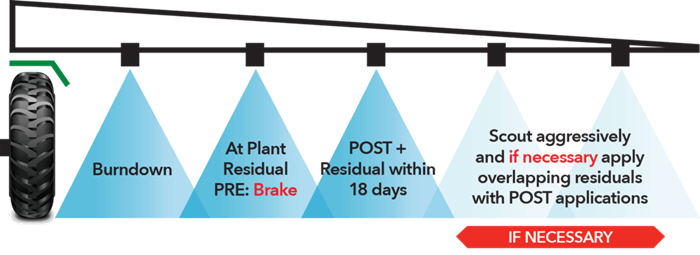The Brake System
The comprehensive herbicide system should be customized for the cotton traits being utilized. See below for more details and trait-based specific recommendations. Always read and follow label use directions and contact a SePRO Technical Specialist with any questions.
- Pre-plant burndown/cultivate
- Apply Brake at-planting
- Apply early POST within 18 days after planting
- Scout and utilize late post and/or layby (as needed).

Proven and Recommended Cotton Herbicide Program
- Brake is a proven foundation residual herbicide for cotton.
- An early POST applied within 18 days of planting using glufosinate (or 2,4-d/dicamba) plus a residual is REQUIRED. Only use POST applied materials that are compatible with the cotton trait being grown.
- With the extended residual of Brake, the need for additional later season POST and layby expenses may be unnecessary.
Pre-Plant
The first essential step is to destroy all existing weeds via a pre-plant herbicide program along with tillage to prepare the field. Starting clean is the only way to stay clean and attain zero-tolerance control when dealing with Palmer amaranth. If cultivation is used, don’t assume that all existing Palmer amaranth is dead following cultivation. Small plants covered with a light layer of soil can be shielded from the burndown spray, making it less effective and allowing the plant to recover quickly.
When spraying Brake at planting following a pre-plant burndown program in which no additional cultivation is conducted, an additional burndown treatment behind the planter may be recommended to manage any escapes (such as Gramoxone®). Brake is not a postemergence herbicide; once weeds have established Brake is not effective at providing control. Apply in a manner that will ensure uniform application, and good coverage, over the field.
Irrigation or Rainfall for Activation
A minimum of 0.5 inches of rain or sprinkler irrigation is required to activate Brake following a surface application. Brake is less effective under dry or drought conditions.
Foliar Post Applications
Always apply an early post treatment as part of a Brake weed control program. Control of early escapes and the application of an early post treatment within 18 days after planting, that includes an overlapping residual (e.g. Warrant® or Dual®), are still essential components of the Brake adaptive management program. Aggressive scouting is recommended and integrate other herbicides for morning glory, nutsedge, or grass control. Only use herbicides that are compatible with the cotton variety being grown. If uncertain, contact a local extension agent or crop consultant to verify herbicide tolerance for different cotton varieties.
The purpose of the overlapping residuals and post applied materials is to eliminate all Palmer amaranth escapes for a zero-tolerance strategy. In the case of a Roundup-based system, the use of overlapping residuals is required to prevent Palmer amaranth from becoming established. Brake is a very effective preemergence herbicide, but the use of overlapping residuals is required because Palmer amaranth is a zero-tolerance weed. Palmer has multiple flushes throughout the growing season, can germinate through areas of soil disturbances, and different environmental conditions can influence herbicide effectiveness. Do not delay POST application beyond the required intervals to maintain adequate Palmer amaranth control.
Rates and Efficacy
Brake can be tank-mixed with other pre-emergent herbicides or products depending on weed spectrum. It is recommended to save Warrant, Dual and other potential post-applied residuals for early post and late post applications with glyphosate or Liberty® over the top of cotton, depending on the cotton variety being used. Brake use rates are 16 - 32 fl. oz/ac and can be tank mixed with most herbicides labeled for cotton.
Mixing
Brake has been observed to be compatible with many other herbicides. Due to the many herbicide formulations available, always conduct a jar test in a small container to determine if there are any compatibility issues prior to tank-mixing in the field. Do not tank-mix with spray adjuvants containing polyacrylamide. Do not mix with other products without first testing compatibility using a jar test.
Always read and follow label directions. Prowl and Liberty are registered trademarks of BASF Corporation. Warrant is a registered trademark of the Monsanto Company. Dual Magnum and Gramoxone are registered trademarks of Syngenta Crop Protection LLC. Treflan is a registered trademark of The Dow Chemical Company or an afiliated company of Dow.
